Well adapter - alternative solution
Any specialist will tell you that the water pipes must pass below the level of soil freezing. With the uninterrupted operation of the well, until recently, a caisson or, alternatively, a pit was used for this purpose. But thanks to technical progress, an adapter for the well has now appeared.
How good he is, what his flaws are and how to set it up with your own hands, we will now talk.
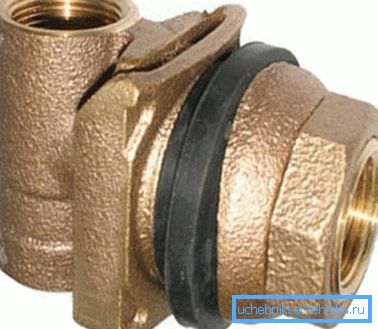
Device and purpose
The adapter to the well is a fairly simple design that provides a tight outlet for a water pipe, powered by a submersible pump, from the casing.. The first mention of the emergence of such devices appeared in the United States, in the second half of the twentieth century. The founder of the design is considered to be John Gordon Baker.
Operating principle
- The well adapter consists of 2 parts, one of which is permanently fixed, by means of a threaded connection with a cap nut, in the wall of the casing and ensures the tightness of the outlet of the water pipe.
- The second part of the design is removable, it fits in with the stationary part on the principle of approaching at an angle into special guides, which are popularly called “dovetail”.
- As a rule, a plastic water-lifting column, on which a submersible pump is mounted, is mounted on the inside of the removable structure from below. (See also the article Which Pump is Better for a Well: Problems of Choice.)
- On top of the part is equipped with a large threaded nozzle. A special rod of the appropriate diameter is screwed into this nozzle, with the help of which, if necessary, the lifting column with a pump can be raised.
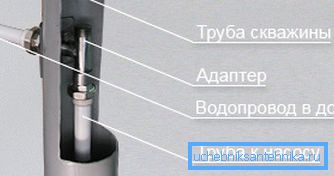
What are the designs
Immediately it should be noted that the adapters for the well, structurally practically do not differ between themselves.
The main difference is in the material from which the product is made.
- Bronze and brass products in the open spaces of our country - this is the most common type of construction. The material is quite durable, according to European standards the use of such structures is prohibited, since there is a significant percentage of lead in the alloys. Plus, although not significantly, the alloys corrode.
- Stainless steel, is less common, as their price is slightly higher.
- DZR is also an alloy of metals, but it does not corrode and is edible.
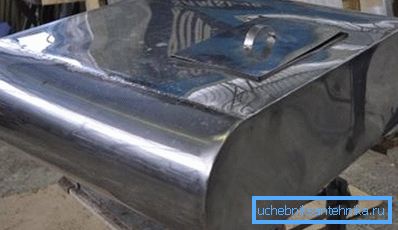
Important: in Europe and the USA, at this time, the use of all types of adapters except DZR or Sanitary Brass is completely prohibited. But GOSTs of our country allow the use of brass, bronze or stainless steel constructions, due to the fact that the area of their contact with water is negligible.

Advantages of the design
- First of all, it is quite affordable price. Compared with the caisson, it can be 5 to 7 times less.
- Installing the adapter on the well is extremely simple and accessible to any owner who can handle a drill.
- Installation work can be performed at almost any time of the year.
- From an aesthetic point of view, the well in the area will hardly be noticeable, which is very good for truckers who fear pump theft.
- To maintain and repair such a well is extremely simple. In addition to the periodic replacement of rubber gaskets, there is practically nothing to break in the design of the adapter itself.
Important: if you plan to install the adapter on a deep well, when arranging the whole structure, we advise you to take steel pipes for casing. Since plastic tubing PVC can not withstand the weight of the pump and the lifting column.
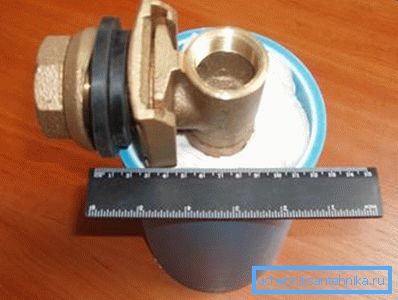
disadvantages
- Disadvantages of this design also have. So, the main sore point here is the replacement of gaskets. More precisely, the gasket that contacts directly with the ground, on average, it becomes unusable in 2 - 3 years. And if it is not changed in time, the ingress of groundwater will not only worsen the quality of the water, but can completely destroy the well.
- The following disadvantage is a derivative of the first. The fact is that the entrance to the casing, as a rule, is below the level of soil freezing, and this is up to 2 m. Therefore, in order to replace one small gasket you have to dig a decent pit.
- Since in our country the vast majority of used brass or bronze, the design must be periodically cleaned of oxides. If you miss this point, then there is a danger that the “dovetail” is soldered with oxides. Then you will have to go deep, cut off a portion of the casing below the entrance level, and mount the caisson.
- Also a disadvantage is the need to place all the water-supply equipment in the house.
- When preparing for the winter in the caisson, you simply turn the knob and drain the water. When using the adapter you will have to tinker.
- When using this device you can not make a separate summer conclusion for watering the garden directly from the well.
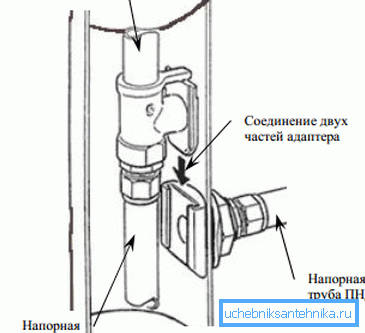
Tip: if you decide to do without a caisson, then the place of tie-in, before digging into the ground, it is better to lubricate abundantly with neutral water-repellent grease and tightly wrap with polyethylene. This will significantly increase the service life. In this case, pay attention to the lubricant, so that it does not react with the rubber and not corroded it.
Caisson or adapter
- Caisson has been known for quite some time, its simplicity and reliability has been proven by time. Of course, in comparison with the adapter, installing a caisson is a more problematic and costly measure.
- Adapters for a well are a young device, they are mounted simply and quickly, but this simplicity is deceptive, afterwards regular and rather problematic preventive work on replacing gaskets and cleaning the connection of well parts is waiting for you.
- In our opinion, the installation of such a device is acceptable in places where it is not possible to install a caisson, in summer cottages that have been used exclusively since summer or as a temporary option before installing the caisson.
- In any case, it is up to you to install an adapter or a caisson for a well; you must take it individually, depending on the location and depth of the well, the condition of the soil, and finally, the owner’s readiness to invest in the construction of the well structure.

Mounting construction
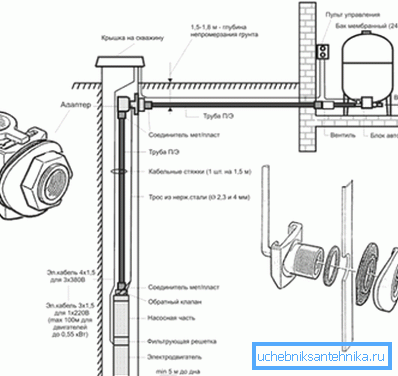
- Installation instructions are extremely simple. Begin by digging out the pit around the casing, to the depth of installation of the structure.
- Using a crown, make a hole of the required diameter.
- Install the stationary part of the structure from the inside and fasten it with a cap nut.
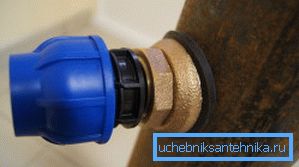
- Mount the tip on the casing.
- Connect the water pipe to the building.
- Assemble the water-lifting column and attach the second part of the structure to it.
- Lower the entire structure into the well and connect both sides of the adapter.
- Attach the steel cable that guards the deep well pump to the tip.
- When selecting an adapter, consider the diameter of the casing and the size of the pump so that the design does not block the removal of the pump.
The video in this article clearly shows the process of mounting the adapter.
Conclusion
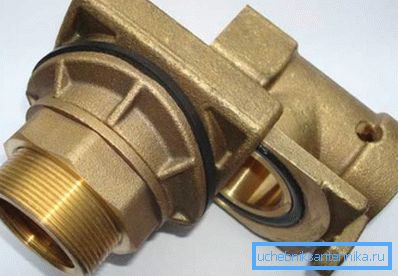
In our opinion, an adapter for a well is quite an acceptable option if you equip the water supply for the dacha, plus a water depth of no more than 50 m. Such wells are designed on average for operation up to 15 years, and it does not make sense to invest extra money. Successes!